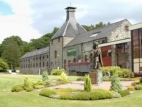 Newton Bridge is a very popular stopping point for walkers or picnics. The River Almond flows under the bridge giving the area a peaceful serenity before carrying on down through the Sma' Glen.
Newton Bridge is a very popular stopping point for walkers or picnics. The River Almond flows under the bridge giving the area a peaceful serenity before carrying on down through the Sma' Glen.More Scottish Photographs
Aberfeldy is a town in Highland Perthshire, Scotland, located on the River Tay, and close to Loch Tay and Kenmore. Robert Burns featured the town of Aberfeldy in his poem, The Birks of Aberfeldy, and it is mentioned in the traditional, and beautiful, Loch Tay Boat Song.
 Newton Bridge is a very popular stopping point for walkers or picnics. The River Almond flows under the bridge giving the area a peaceful serenity before carrying on down through the Sma' Glen.
Newton Bridge is a very popular stopping point for walkers or picnics. The River Almond flows under the bridge giving the area a peaceful serenity before carrying on down through the Sma' Glen. A dull Sunday afternoon but Glen Lyon never ceases to be breathtaking. Glen Lyon is one of Scotland's most beautiful glens. It starts at Fortingall and runs for some 20 miles to Cashlie. Over the journey it changes dramatically in character. At its base the River Lyon has cut a deep gorge known as MacGregor's leap. It gets its name from an outlaw member of the MacGregor clan, who is said to have escaped justice by leaping the falls. Watch out for the ruined stone bridge, which dates back to the late 18th century, on the opposite bank
A dull Sunday afternoon but Glen Lyon never ceases to be breathtaking. Glen Lyon is one of Scotland's most beautiful glens. It starts at Fortingall and runs for some 20 miles to Cashlie. Over the journey it changes dramatically in character. At its base the River Lyon has cut a deep gorge known as MacGregor's leap. It gets its name from an outlaw member of the MacGregor clan, who is said to have escaped justice by leaping the falls. Watch out for the ruined stone bridge, which dates back to the late 18th century, on the opposite bank The FAIRTRADE Mark is an independent consumer label which appears on products as an independent guarantee that disadvantaged producers in the developing world are getting a better deal.
The FAIRTRADE Mark is an independent consumer label which appears on products as an independent guarantee that disadvantaged producers in the developing world are getting a better deal.







 This map is part of the Ordnance Survey's Explorer series designed to replace the old Pathfinder map series. At 1:25,000 scale this detailed map shows a host of Aberfeldy area attractions including gardens which are open to the public, nature reserves and country parks as well as all official footpaths, bridleways, roads and lanes. Aberfeldy Maps.
This map is part of the Ordnance Survey's Explorer series designed to replace the old Pathfinder map series. At 1:25,000 scale this detailed map shows a host of Aberfeldy area attractions including gardens which are open to the public, nature reserves and country parks as well as all official footpaths, bridleways, roads and lanes. Aberfeldy Maps.
Loch Tay Boat Song
When I've done my work of day,
And I row my boat away,
Doon the waters of Loch Tay,
As the evening light is fading
And I look upon Ben Lawers
Where the after glory glows;
And I think on two bright eyes
And the melting mouth below.She's my beauteous nighean ruadh,
She's my joy and sorrow too;
And although she is untrue,
Well I cannot live without her,
For my heart's a boat in tow,
And I'd give the world to know
Why she means to let me go,
As I sing horee horo.Nighean ruadh, your lovely hair
Has more glamour I declare
Than all the tresses rare
'tween Killin and Aberfeldy.
Be they lint white, brown or gold,
Be they blacker than the sloe,
They are worth no more to me
Than the melting flake of snow.Her eyes are like the gleam
O' the sunlight on the stream;
And the songs the fairies sing
Seem like songs she sings at milking.
But my heart is full of woe,
For last night she bade me go
And the tears begin to flow,
As I sing horee, horo.She's my beauteous nighean ruadh,
She's my joy and sorrow too
And although she is untrue,
Well I cannot live without her.
For my heart's a boat in tow
And I'd give the world to know,
Why she means to let me go
As I sing horee horo.
 By the Aberfeldy Bridge you will find the Black Watch memorial commemorating the raising of the world famous regiment. In the wake of the 1715 Scottish rebellion, companies of trustworthy Highlanders were raised from loyal clans. They became known as the Black Watch for the watch they kept on the Highlands and from their dark government tartan.
By the Aberfeldy Bridge you will find the Black Watch memorial commemorating the raising of the world famous regiment. In the wake of the 1715 Scottish rebellion, companies of trustworthy Highlanders were raised from loyal clans. They became known as the Black Watch for the watch they kept on the Highlands and from their dark government tartan.

